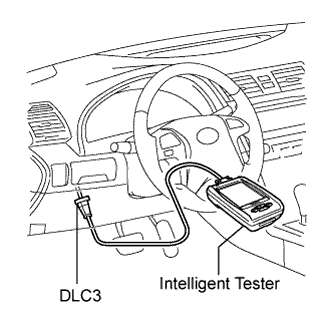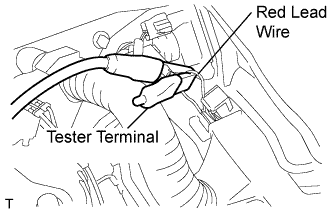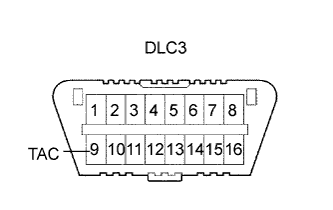Engine -- On-Vehicle Inspection |
| 1. INSPECT ENGINE COOLANT |
Inspect the engine coolant (CAMRY_ACV40 RM000000V1Q01FX.html).
| 2. INSPECT ENGINE OIL |
Inspect the engine oil (CAMRY_ACV40 RM000001IQG006X.html).
| 3. INSPECT BATTERY |
Inspect the battery (CAMRY_ACV40 RM000001AR900IX.html).
| 4. INSPECT SPARK PLUGS |
Inspect the spark plugs (CAMRY_ACV40 RM000001IQS004X_02_0003.html).
| 5. INSPECT AIR CLEANER FILTER ELEMENT SUB-ASSEMBLY |
Remove the air cleaner filter element sub-assembly.
Visually check that there is no dirt, blockage, and/or damage to the air cleaner filter element.
- HINT:
- If there is any dirt or a blockage in the air cleaner filter element, clean it with compressed air.
- If any dirt or a blockage remains even after cleaning the air cleaner filter element with compressed air, replace it.
| 6. INSPECT VALVE LASH ADJUSTER NOISE |
Rev up the engine several times. Check that the engine does not emit unusual noises.
If unusual noises occur, warm up the engine and idle it for over 30 minutes. Then repeat this procedure.- HINT:
- If any defects or problems are found during the inspection above, perform lash adjuster inspection (CAMRY_ACV40 RM000000XCV00QX_01_0016.html).
| 7. INSPECT IGNITION TIMING |
Warm up the engine.
When using the intelligent tester:
Check the ignition timing.Connect the intelligent tester to the DLC3.
Enter DATA LIST mode with the intelligent tester.
- Ignition timing:
- 8 to 12° BTDC at idle
- HINT:
- Refer to the intelligent tester operator's manual for help when selecting the DATA LIST.
 |
When not using the intelligent tester:
Check the ignition timing.Using SST, connect terminals 13 (TC) and 4 (CG) of the DLC3.
- SST
- 09843-18040
- NOTICE:
- Confirm the terminal numbers before connecting them. Connection with a wrong terminal can damage the engine.
- Turn off all electrical systems before connecting the terminals.
- Perform this inspection after the cooling fan motor is turned off.
Remove the V-bank cover.
Pull out the red lead wire harness.
Connect the tester terminal of the timing light to the red lead wire as shown in the illustration.
- NOTICE:
- Use a timing light which can detect the first signal.
Check the ignition timing at idle.
- Ignition timing:
- 8 to 12° BTDC at idle
- NOTICE:
- When checking the ignition timing, the transmission should be in neutral.
- HINT:
- Run the engine at 1,000 to 1,300 rpm for 5 seconds, and then check that the engine rpm returns to idle speed.
Disconnect terminals 13 (TC) and 4 (CG) of the DLC3.
Check the ignition timing at idle.
- Ignition timing:
- 12 to 22° BTDC at idle
Confirm that the ignition timing moves to the advanced angle side when the engine rpm is increased.
Remove the timing light.

 |
| 8. INSPECT ENGINE IDLE SPEED |
Warm up the engine.
When using the intelligent tester:
Check the idle speed.Connect the intelligent tester to the DLC3.
Enter DATA LIST mode with the intelligent tester.
- Idle speed:
- 600 to 700 rpm
- NOTICE:
- When checking the idle speed, the transmission should be in neutral.
- Check the idle speed with the cooling fan off.
- Switch off all accessories and air conditioning before connecting the intelligent tester.
- HINT:
- Refer to the intelligent tester operator's manual for further details.
 |
When not using the intelligent tester:
Check the idle speed.Using SST, connect the tachometer test probe to terminal 9 (TAC) of the DLC3.
- SST
- 09843-18030
Check the idle speed.
- Idle speed:
- 600 to 700 rpm
 |
| 9. INSPECT COMPRESSION |
Warm up and stop the engine.
Disconnect the injector connectors.
Remove the intake air surge tank (CAMRY_ACV40 RM000001IR3003X.html).
| 10. INSPECT CO/HC |
Start the engine.
Run the engine at 2,500 rpm for approximately 180 seconds.
Insert the CO/HC meter testing probe at least 40 cm (1.3 ft) into the tailpipe during idling.
Check CO/HC concentration at idle and/or 2,500 rpm.
- HINT:
- Check regulations and restrictions in your area when performing 2 mode CO/HC concentration testing (engine check at both idle speed and at 2,500 rpm).
- If the CO/HC concentration does not comply with regulations, perform troubleshooting in the order given below.
Check A/F sensor and heated oxygen sensor operation.
See the table below for possible causes, and then inspect and repair.
CO HC Problems Causes Normal High Rough idle - Faulty ignitions:
- Incorrect timing
- Fouled, shorted or improperly gapped plugs
- Incorrect valve clearance
- Leaks in intake and exhaust valves
- Leaks in cylinders
Low High Rough idle
(fluctuating HC reading)- Vacuum leaks:
- PCV hoses
- Intake manifold
- Throttle body
- Brake booster line
- Lean mixture causing misfire
High High Rough idle
(black smoke from exhaust)- Restricted air filter
- Plugged PCV valve
- Faulty SFI system:
- Faulty fuel pressure regulator
- Defective engine coolant temperature sensor
- Defective MAF meter
- Faulty ECM
- Faulty injectors
- Faulty throttle position sensor
- Faulty ignitions: